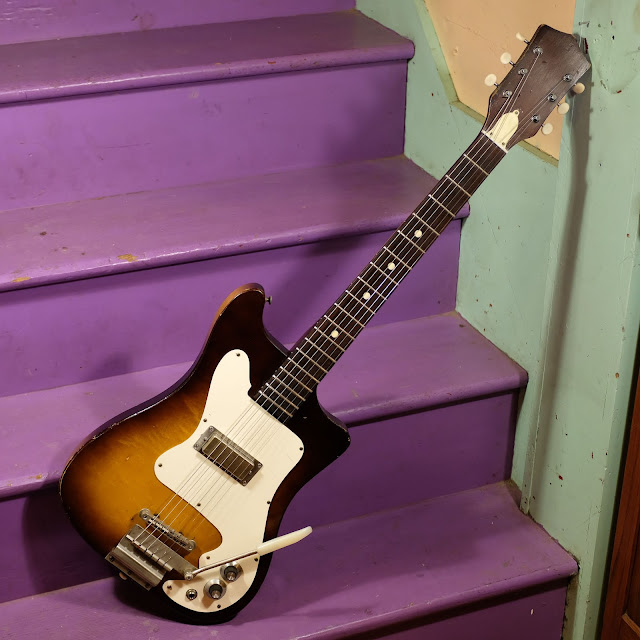1960s Kay Vanguard (Modded) Electric Guitar
My crazy-projects compatriot Mr. Steve owns this guitar. It was his first guitar and it made its way back to him by hook or by crook after trading it off. Ironically, a Kay Vanguard was also the first electric guitar I owned. I'd been borrowing my Dad's old '60s surf-green-turned-avocado Hofner 172 until I got my Vanguard. Interestingly, though, Steve's Vanguard is a solid-body instrument whereas mine was semihollow, even though they look the same. Quick explanation: Kay used thin ply maple on the tops and backs of these and a solid poplar in-between layer. Some of them were heavily cut-out like '60s Harmony Stratotones to make them almost-hollowbodies inside.
Anyhow, this guitar had been sitting unused and kept as a yearning for first-guitar-love years. Mr. Steve had been talking to me about his mild regret for that fact and came-up with a scheme to turn it into a guitar he'd use. I mean, as much as I love funky old Kay electrics, the pickups and wiring harness that came with these were not top-notch. They tend to sound dark and muffled.
Work included: making his wish-list come true: new jumbo frets, good tuners, a Maestro Vibrola-style whammy unit (there was just enough room to mount it), a new pickup, and a practical bridge. It got all that, plus side dots, and a new wiring harness, too. The pickup is a Fralin Firebird type, the tuners are StewMac Golden Age Kluson-style repros, the bridge is a Gotoh TOM unit (my favorite of that type), and the whammy is an Allparts piece, as far as I know. All of the new hardware came in "relic" or "raw" states to fit with the age of the guitar. After work it plays, sounds, and feels like some sort of offbeat modern boutique instrument -- with the charm of actually being old. Action is spot-on at 1/16" overall at the 12th fret, it's strung with 50w-11, the truss works, and it's good to go.
Scale length: 25 3/4"
Nut width: 1 11/16"
String spacing at nut: 1 7/16"
String spacing at saddle: 2 1/16"
Nut width: 1 11/16"
String spacing at nut: 1 7/16"
String spacing at saddle: 2 1/16"
Body length: 16 1/2"
Lower bout width: 12 1/4"
Upper bout width: 10"
Lower bout width: 12 1/4"
Upper bout width: 10"
Side depth at endpin: 1 1/2"
Body wood: poplar
Body veneer wood: ply maple back/front
Neck wood: poplar
Fretboard: rosewood
Body veneer wood: ply maple back/front
Neck wood: poplar
Fretboard: rosewood
Neck shape: 12" radius w/medium D-shaped rear
Bridge: new Gotoh relic TOM, adjustable
Nut: new bone
Whammy: Maestro Vibrola repro
Condition notes: because I didn't want to rock the pickguard-recutting boat too much, the pickup is not 100% on-center with the strings, though the output is balanced and all is well.
The funny thing about Kay Vanguards is that folks often assume they're short-scale, student-style models. They've got the last part correct, but the scale length is actually longer than most manufacturers at 25 3/4" -- a full 1/4" beyond Fender's professional models. Because this same neck type was mostly destined for longer-bodied hollowbody instruments, the way they set the scale on the neck means that it pushes the bridge way down the body on these smaller-body solid instruments.
When you play it, the natural picking position for your arm is then north of the pickup and right at the bottom of the fretboard. It definitely makes you play the thing morel like a jazz guitar.
The Fralin pickup is top-notch. I've installed several, recently, and the owners report kind phonecalls from Mr. Fralin himself after their purchases to confirm details before winding them.
The new Vibrola unit meant I had to knock the neck angle back with a shim at the neck pocket, but that was totally worth it as it's so fun to use this with a long-scale, higher-tension neck vs. the usual Gibson 24 3/4" or so. That extra tension means it works beautifully rather than "pretty decent." After yanking on the strings to stretch them out, the guitar was staying in tune nicely while strong-arming it.
The new wiring harness has two 500k pots, a new jack, new ground wire to the tailpiece (imagine that!), and the cavity and pickguard are also now shielded. Details make a difference...
The StewMac Golden Age tuners are a huge step up compared to the cheesy, cheap, Japan-import tuners that were on this originally.


















Comments
PM: about the same footprint?